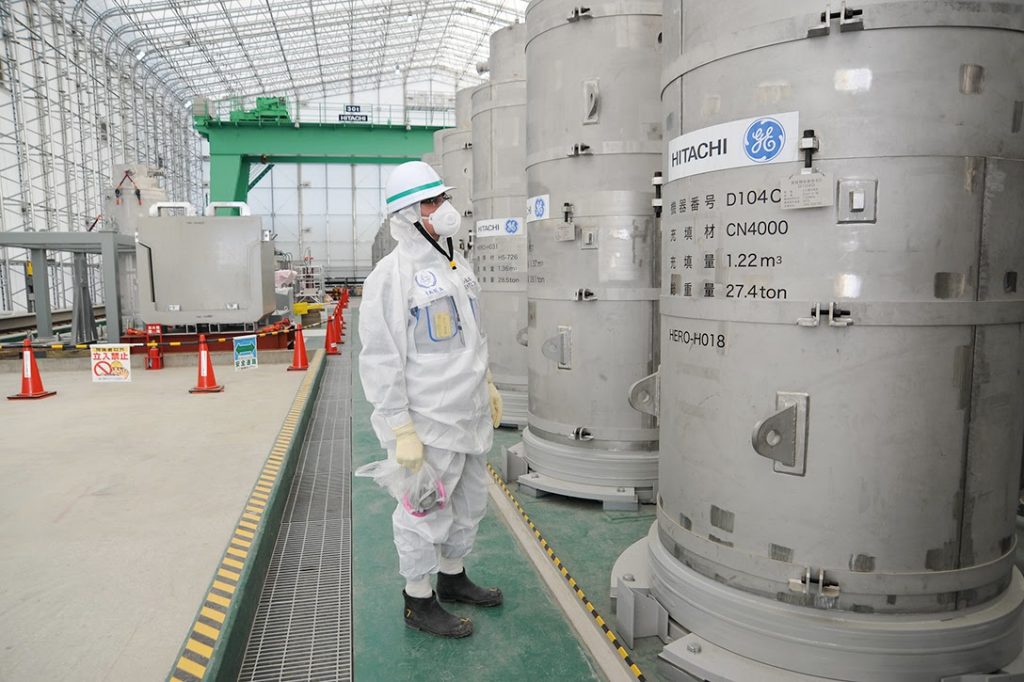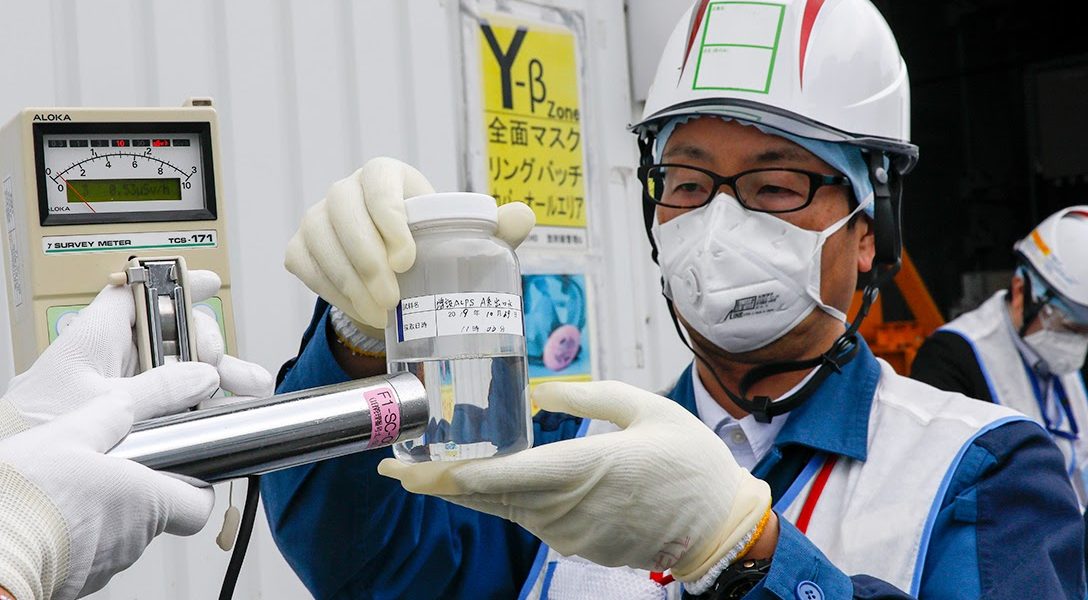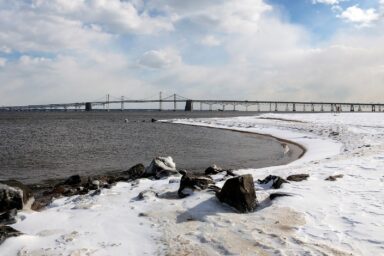Planning to attend the Summer Olympics in Japan? You may want to bring along a Geiger counter — and a face mask.

The 2020 Summer Olympics are coming to Japan — despite two major health scares: radiation from the nuclear meltdown at Fukushima and, more recently, the coronavirus. Over half of the coronavirus cases outside of China were onboard a cruise ship docked in Japan. (On board, 634 cases; on land, another 93, but these figures constantly change.)
The Japanese government is handling the coronavirus outbreak much the same way China handled it: not by controlling the situation, but by controlling information about the situation.
And this is the same way the Japanese government is handling the Fukushima crisis. Prime Minister Shinzo Abe told the Olympic Committee that the nuclear meltdowns at Fukushima are not a problem.
“Let me assure you, the situation is under control,” he said in 2013.
That was a lie — one that let Olympic planning proceed by virtue of official denial of nuclear uncertainty with lethal potential.
And now the Olympics may also be threatened by a health crisis of another sort: Japan’s botched handling of the coronavirus.
Japan’s official response to this new threat has already drawn criticism, especially for releasing hundreds of possibly exposed passengers from a cruise ship into the general population. The dysfunction of Japan’s response to this crisis is illustrated by the fact that its environment minister skipped a government meeting on the coronavirus outbreak in favor of a political celebration in his home town. The Bangkok Post argues that time is running out on the Tokyo Olympics:
Japan needs to rethink the Olympics. The most pressing reason to postpone or cancel the 2020 Tokyo summer games, which are due to start in late July, is a raging public health crisis of unknown dimensions. The second most important reason to put the Olympics on hold is the Japanese government response to the public health crisis to date: it has shown itself to have feet of clay.
At the same time, organizers of the Tokyo marathon on March 1 have limited participation to about 200 athletes, after originally expecting 38,000.
Meanwhile, the governor of Fukushima Prefecture was reassuring the public that radiation is no threat to the safety of the Olympic torch run on March 26: “Through this ‘Reconstruction Olympics,’ we would like to show how Fukushima’s reconstruction has progressed in the past nine years as the result of efforts in cooperation with the Japanese government.”
“Using Greenpeace’s calculations, people staying near the stadium could be exposed to a greater amount of radiation in just over a day than they would naturally experience in a year.”
There is no way to know how the coronavirus spread will play or what effect, if any, it will have on the Summer Olympics. But it’s clear that the Japanese government has a huge stake in minimizing the perceived threat, exercising a level of denial that mirrors the official reassurances about Fukushima over the past nine years.
Judging by the head of the Australian Olympic Committee’s response, the Japanese reassurances are being taken at face value, albeit with significant caveats:
They’ve made it quite clear to us that there is no case for postponing, cancelling the Games at all … provided that all of the requirements of the Japanese authority on people coming into the Games are followed … We’re very satisfied that all the checks and balances will be there by the time the athletes and the spectators enter the country.
Although the Tokyo Olympics committee tells everyone that none of the Olympic playing fields are radioactive, there have been reports to the contrary near Fukushima. South Korean athletes plan to bring their own food and radiation detectors. (Australian and US athletes will eat Japanese-prepared meals.)
The Hot Spots
The J-Village National Training Center is an Olympic sports complex that includes a stadium, 11 soccer fields, a swimming pool, a hotel, and conference center — all located about 12 miles from the ruined reactors at Fukushima.
Last December, the environmental organization Greenpeace published a study documenting radioactive hot spots at J-Village, and found in some areas radiation levels as much as 1,700 times higher than they had been in 2011 before the meltdowns.
Greenpeace also found radiation levels roughly 280 times higher than those promised by the Japanese government. As CNN reported: “Using Greenpeace’s calculations, people staying near the stadium could be exposed to a greater amount of radiation in just over a day than they would naturally experience in a year.”
While Greenpeace found that most of the J-Village site was not highly radioactive, the organization questioned the Tokyo Electric Power Co.’s (TEPCO) approach to cleaning up the hot spots at the site:
How were such high levels of radiation not detected during the earlier decontamination by TEPCO? Why were only the most alarming hotspots removed and not the wider areas following the standard decontamination procedures? Given these apparent failures, the ability of the authorities to accurately and consistently identify radiation hot spots appears to be seriously in doubt.
On January 21, Fukushima Prefecture officials issued a statement assuring the public that radiation levels “won’t be posing any problem for holding the torch relay,” and that radiation exposure would be less than the exposure during a flight from New York to Tokyo.
The statement provided no details explaining any ongoing safety measures: what measures had been taken to decontaminate hot spots, what effort was being made to search out other hotspots, or any other details of decontamination procedures.
https://www.youtube.com/watch?v=zHtgTu4qjUw
A Disaster in Slow Motion
The 2011 nuclear meltdowns at Fukushima may now be widely ignored or forgotten, but the Fukushima Daiichi nuclear power plant remains an evolving, multi-faceted disaster proceeding in slow motion. Radiation is constantly leaking from the nuclear complex where three melted nuclear cores remain a threat should they lose the water that keeps the meltdowns from reigniting.
For now there’s ample water to keep the cores cool, mainly because TEPCO has jury-rigged enough plumbing in the damaged plants to continue pumping water that keeps the cores and fuel pools covered and the meltdowns in check. No one really knows the configuration of the cores, which are presumably in a molten heap on the floor of the containment building, with lethal levels of radioactivity. Robots have made some contact with the cores, but their safe removal is years away.
TEPCO must continue to pump water to keep the cores cool for the indefinite future. As it’s pumped through the system, the fresh water becomes too radioactive itself to release into the environment. So the authorities have been storing this water in giant on-site tanks — now more than 1,000.
They say they’ll run out of room for more tanks in another year or so. The tanks currently hold an estimated 1.2 million tons — more than 300 million gallons — of radioactive water that continues to accumulate at an estimated rate of 1,000 tons (265,000 gallons) or more per week.
No Solution in Sight
TEPCO, which owns the Fukushima complex, and the Japanese government understand the problem well enough, but they have yet to find a reasonable solution. The International Atomic Energy Agency (IAEA) overseeing the Fukushima operation calls for replacing the temporary storage tanks with a permanent solution. Although no feasible permanent solution exists, three have been proposed: Evaporate the water, bury the water deep underground, or pump the water into the Pacific. There is no consensus in support of any of these.
The Japanese government and TEPCO have been advocating the Pacific Ocean dumping solution for more than two years. Authorities say the water has been decontaminated, but this has never been true. At best, the water contains high levels of radioactive, carcinogenic tritium. The filtration device used on the water, the Advanced Liquid Processing System (ALPS), is unable to remove tritium.
In 2017, TEPCO was claiming that ALPS had cleaned the water of every radionuclide other than tritium. That was not true. In August 2018, TEPCO admitted that the treated water still contained radioactive contaminants including iodine, cesium, and strontium, some of them above officially designated safe levels.
As the IAEA has documented, the authorities have released controlled amounts of radioactive water from Fukushima into the Pacific for years. Additionally, uncontrolled radioactive groundwater has flowed into the Pacific continuously since the 2011 disaster, although that flow has been substantially reduced. As the Fukushima site runs out of storage space, the campaign to release 300 million gallons of radioactive wastewater into the Pacific has intensified.
In November 2019, the Bulletin of the Atomic Scientists published a status report on Fukushima that began:
After more than eight years, Japan is still struggling with [the] aftermath of the 2011 Fukushima nuclear disaster. The Japanese government and nuclear industry have not solved the many technical, economic, and socio-political challenges brought on by the accident. More worrying, they continue to put special interests ahead of the public interest, exacerbating the challenges and squandering public trust.
Among the problems at Fukushima, the Bulletin cited a highly radioactive exhaust stack that is at risk of collapse and needs to be carefully removed. In 2019, in its first attempt to remove the stack, TEPCO constructed a tower that was three meters too short to do the job. Other glitches have plagued this operation, which is ongoing.
The Bulletin also noted that a subcommittee of the Ministry of Economy, Trade and Industry recommended dumping treated wastewater with a low level of tritium into the Pacific. However, this plan was stalled by the authorities’ failure to reduce radioactivity to safe levels — or to tell the truth about it.
“Releasing Fukushima radioactive water into ocean is an appalling act of industrial vandalism.”
Further complicating the clean-up at Fukushima, according to the Bulletin, is that none of the institutions involved is a disinterested party and none is willing to accept “a truly independent third party to oversee their activities.”
In December 2019, the New York Times approached the Fukushima story from the perspective of a fisherman whose life has been devastated by the disaster. The fishing industry is operating at about one-fifth the capacity of its pre-meltdown level and is one of the strongest opponents of more dumping. According to the Times:
The water from the Fukushima disaster is more radioactive than the authorities have previously publicized, raising doubts about government assurances that it will be made safe … Some scientists said they would need proof before believing that the Fukushima water was treated to safe levels.

The government official in charge of contaminated-water management acknowledged public concern about the issue, “even though there is no scientific evidence that the water is dangerous.” As if to reinforce that opinion, TEPCO officials hosted a media tour of the Fukushima plant on January 29. Radioactivity on the site is varied, but workers mostly wear protective gear and some jobs are so dangerous only robots are used.
On January 31, after six years of consideration, an advisory panel made a preliminary recommendation to the government to release Fukushima wastewater into the Pacific. The panel decided that this was better than the only alternative they considered feasible: evaporating the water. The recommendation has to be approved by panel chair Ichiro Yamamoto, a step required before the government considers it.
“There should be no delays to decommissioning the plant,” Yamamoto said. There is no reliable estimate as to how long decommissioning the plant’s damaged fuel pools and melted-down reactors will take, but it will surely run to decades. TEPCO’s own timeline stretches past 2050.
On February 3, the Japanese Foreign Ministry briefed 28 diplomats from 23 countries about the proposed radioactive-water dumping into the Pacific. The US did not participate in the briefing. The ministry assured the diplomats that “release of tainted water from Fukushima would have no impact on oceans.” According to the ministry, none of the diplomats voiced any objection to the proposal. The government plans to hold hearings on the proposal.
Reacting to the briefing, Common Dreams (a nonprofit US-based progressive news website) reported: “Nuclear policy expert Paul Dorfman said Saturday, ‘Releasing Fukushima radioactive water into ocean is an appalling act of industrial vandalism.’ Greenpeace opposes the plan as well.”
While South Korea may not have spoken up at the Fukushima briefing, it maintains a ban on Fukushima fish, and closely monitors other produce from Fukushima and seven neighboring prefectures (administrative areas) north and south of it. (Go here for details.)
Chernobyl: The Nuclear Disaster That Helped Destroy a Regime
Happy Talk
Current media coverage of Fukushima, where it exists, is mostly happy talk about the Olympics and how safe the country has become in the wake of the Fukushima disaster. Radiation that will persist for thousands of years and quiescent nuclear reactors whose meltdowns could reignite any time something else goes wrong are largely ignored.
“Wildlife is thriving in radioactive Fukushima,” according to the Wildlife Society of Bethesda, MD, on February 6, 2020. The Society’s reporting is based on a 2020 study published by the Ecological Society of America in Washington, DC. The limited study used remote sensors to gather data from areas radiologically unsafe for humans (in the so-called human-evacuation zone).
The study found that the radioactive region was repopulated with native mammals and birds, but could reach no conclusion regarding the impact of radiation on individuals or any of their molecular structure. According to the abstract:
Using a network of remote cameras placed along a gradient of radiological contamination and human presence, we collected data on population‐level impacts to wildlife (that is, abundance and occupancy patterns) following the 2011 Fukushima Daiichi nuclear accident. We found no evidence of population‐level impacts in mid‐to large‐sized mammals or gallinaceous birds, and show several species were most abundant in human‐evacuated areas, despite the presence of radiological contamination. These data provide unique evidence of the natural rewilding of the Fukushima landscape following human abandonment, and suggest that if any effects of radiological exposure in mid‐to-large‐sized mammals in the Fukushima Exclusion Zone exist, they occur at individual or molecular scales….
In other words, the researchers have no idea whether or not these populations are “thriving,” only that they appear to have reestablished themselves in pre-meltdown numbers in areas still deemed unsafe for humans.
Related front page panorama photo credit: Adapted by WhoWhatWhy from IAEA Imagebank / Flickr (CC BY 2.0).



